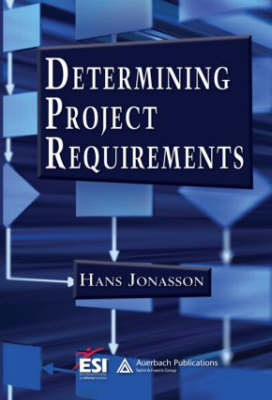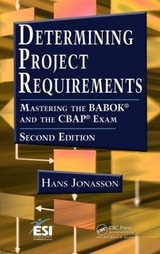
Determining Project Requirements
Seiten
2007
Auerbach (Verlag)
978-1-4200-4502-4 (ISBN)
Auerbach (Verlag)
978-1-4200-4502-4 (ISBN)
- Titel erscheint in neuer Auflage
- Artikel merken
Zu diesem Artikel existiert eine Nachauflage
Offers a set of processes designed to ensure communication between customers and developers. This book covers the role of business analyst, the evolution of business analysis, and standard setting forces in the industry. It includes built-in exercises, practices, tools, and templates, and general and customisable solutions.
Organizations waste millions of dollars every year on failed projects. Failure is practically guaranteed by poor or incomplete requirements that do not properly define projects in their initial stages. Business analysis is the critical process ensuring projects start on the path toward success. To accurately determine project requirements, business analysts must be experts at business, communication, facilitation, negotiation, and this book is a step-by-step manual for honing these skills. Drawing from the author’s more than 20 years in industry and ten years in teaching, Determining Project Requirements provides the essential techniques for business analysis. The book steps through each analysis phase from the initial idea stage to the final defined and validated requirements. The book covers the professional role of business analysts, the evolution of business analysis, and current and emerging standards. A practical example running throughout the book demonstrates how to nail down customer requirements for all levels of the organization and make sure project teams fully understand what customers require. It also explains how to select the appropriate techniques for analyzing different types of projects and for eliciting a broad range of requirements. The book includes exercises, best practices, tools, templates, and customizable solutions, as well as two examples of the Business Requirements Document. The book thoroughly explores the business analyst’s role in different organizations, the difficulties in capturing requirements, and the tools that assist the analysis process.
With readily applicable theories, tools, and techniques, Determining Project Requirements provides a foundation for formalizing business analysis processes and ensuring project success within the readers organization.
Organizations waste millions of dollars every year on failed projects. Failure is practically guaranteed by poor or incomplete requirements that do not properly define projects in their initial stages. Business analysis is the critical process ensuring projects start on the path toward success. To accurately determine project requirements, business analysts must be experts at business, communication, facilitation, negotiation, and this book is a step-by-step manual for honing these skills. Drawing from the author’s more than 20 years in industry and ten years in teaching, Determining Project Requirements provides the essential techniques for business analysis. The book steps through each analysis phase from the initial idea stage to the final defined and validated requirements. The book covers the professional role of business analysts, the evolution of business analysis, and current and emerging standards. A practical example running throughout the book demonstrates how to nail down customer requirements for all levels of the organization and make sure project teams fully understand what customers require. It also explains how to select the appropriate techniques for analyzing different types of projects and for eliciting a broad range of requirements. The book includes exercises, best practices, tools, templates, and customizable solutions, as well as two examples of the Business Requirements Document. The book thoroughly explores the business analyst’s role in different organizations, the difficulties in capturing requirements, and the tools that assist the analysis process.
With readily applicable theories, tools, and techniques, Determining Project Requirements provides a foundation for formalizing business analysis processes and ensuring project success within the readers organization.
JTC Unlimited, Shelby Twp., Michigan, USA
Introduction
Laying the Foundation
Enterprise Analysis
Creating a Plan for the Requirements Phase
Development Methodologies and Requirements Impact
Categorizing Requirements
Ways to Gather Requirements
Requirements Modeling and Documentation
Effective Requirements Communication
Making Sure the Requirements Are Implemented
Swede-Mart Case Study
Activity Solutions for Swede-Mart Case Study
Appendix A: Acronyms
Appendix B: Business Requirements Document Templates
Appendix C Sources and Bibliography
| Erscheint lt. Verlag | 4.10.2007 |
|---|---|
| Reihe/Serie | ESI International Project Management Series |
| Zusatzinfo | 75 Illustrations, black and white |
| Verlagsort | London |
| Sprache | englisch |
| Maße | 156 x 235 mm |
| Gewicht | 590 g |
| Themenwelt | Mathematik / Informatik ► Informatik ► Theorie / Studium |
| Wirtschaft ► Betriebswirtschaft / Management ► Projektmanagement | |
| ISBN-10 | 1-4200-4502-4 / 1420045024 |
| ISBN-13 | 978-1-4200-4502-4 / 9781420045024 |
| Zustand | Neuware |
| Haben Sie eine Frage zum Produkt? |
Mehr entdecken
aus dem Bereich
aus dem Bereich
was jeder über Informatik wissen sollte
Buch | Softcover (2024)
Springer Vieweg (Verlag)
37,99 €
Grundlagen – Anwendungen – Perspektiven
Buch | Softcover (2022)
Springer Vieweg (Verlag)
34,99 €
Eine Einführung in die Systemtheorie
Buch | Softcover (2022)
UTB (Verlag)
25,00 €



